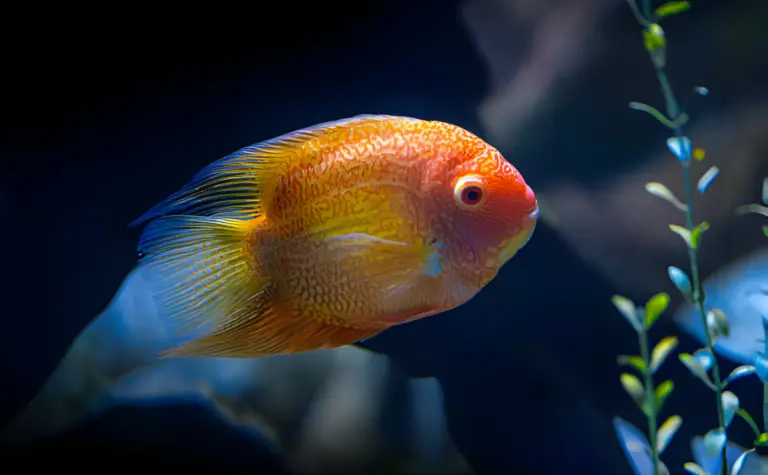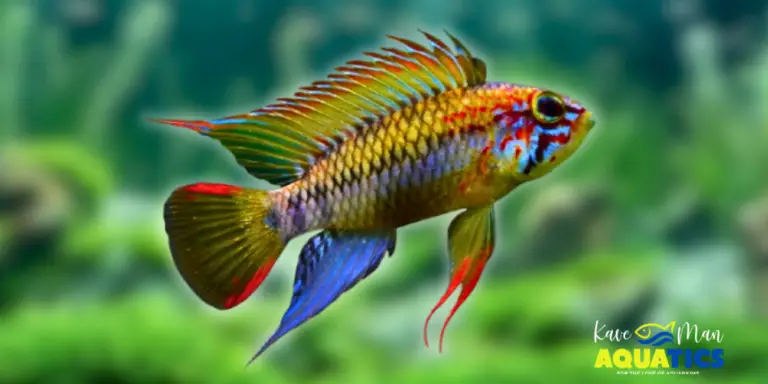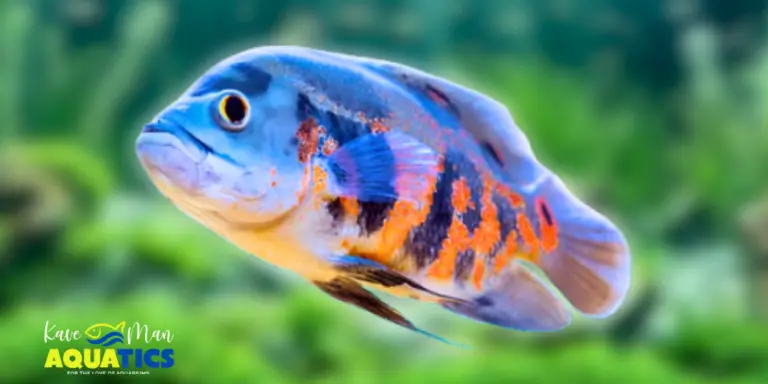All About Arowanas — A Complete Species Profile and Care Guide
If you’ve ever dreamt of having an extraordinary fish companion, look no further than the captivating Arowanas.
In our comprehensive guide, we delve into the depths of Arowanas — their intriguing species profile and the secrets to providing top-notch care. Whether you’re a seasoned fish-keeper or just starting your aquatic adventure, this Arowana care guide will equip you with all the essential knowledge to raise these majestic fish with confidence.
Get ready to dive into the enchanting world of Arowanas and unravel the mysteries that make them one of the most sought-after species in the fish-keeping realm.
Arowanas Overview
| Family | Osteoglossidae |
| Species | O. Bicirrhosum (Silver Arowana), O. Ferreirai (Black Arowana), Scleropages Formosus (Asian Arowana) |
| Common Names | Aro, Dragon Fish, Water Dragon, Bonytongue, Living Fossil |
| Location | South America, Southeast Asia, Australia, Africa |
| Size | 24 – 30 inches (60 – 76 centimeters), depending on the species |
| Life Expectancy | 10 – 25 years average — in captivity, depending on the species |
| Appearance | Elongated body, large, shiny, diamond-shaped scales, large pectoral fins |
| Color | Shades of silver, red, green, gold, black |
| Diet | Carnivores — small fish, insects, bloodworms, brine shrimp, krill, small prawns |
| Behavior | Curious, territorial, has leaping abilities |
| Tank Size | 100 gallons (around 378 liters) per adult Arowana |
| Temperature | 75°F – 82°F (24°C – 28°C) |
| pH | 6.5 – 7.5 |
| Water Type | Freshwater |
| Hardness | Moderate to slightly hard, 6 – 12 dGH (107 – 214 ppm (parts per million) of total dissolved solids (TDS)) |
| Care Level | Moderate — proper knowledge, attention, and dedication |
| Breeding | Paternal mouthbrooders — males are responsible for carrying and protecting the fertilized eggs in their mouths until they hatch |
About the Arowana Fish
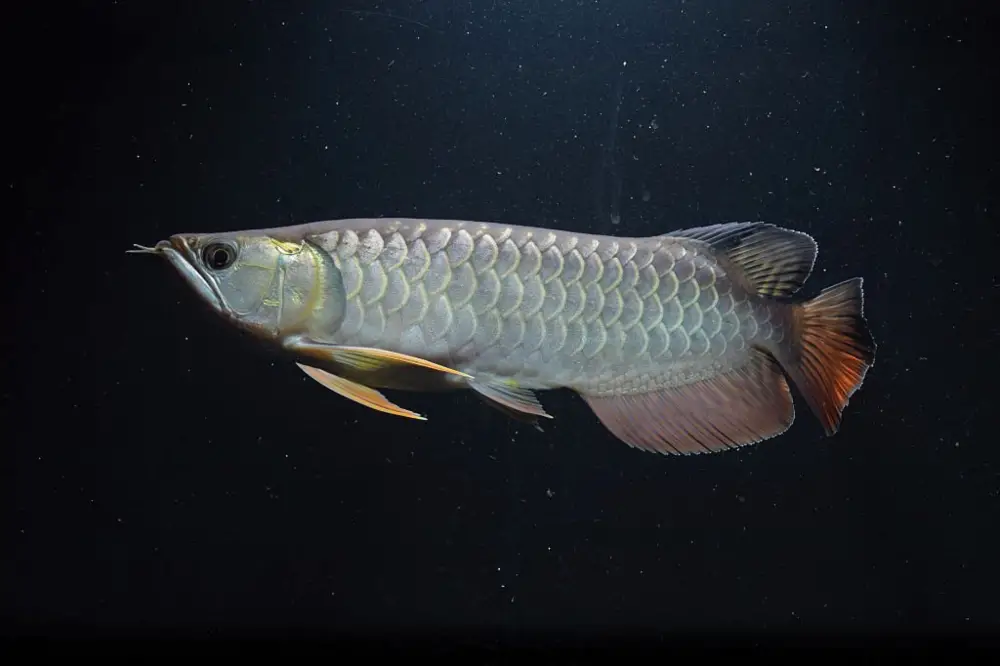
Arowanas are renowned for their graceful movements and striking appearances. With their elongated bodies, unique scales, and impressive fins, Arowanas captivate fish-keepers worldwide.
Our Arowana care guide and species profile will unveil the secrets to keeping these captivating creatures happy and healthy in your aquarium. From their preferred tank conditions to their dietary needs, we’ll guide you every step of the way on your journey with these magnificent Arowana fish.
Distribution and Habitat
Arowanas are native to various regions across the globe, including South America, Southeast Asia, Australia, and Africa. In South America, you can find them gracefully gliding through the Amazon River and its surrounding basins. In Southeast Asia, they thrive in the lush waters of the Mekong River and its tributaries.
In the wild, Arowanas are often found in slow-moving or stagnant waters, like flooded forests, swamps, and backwaters. They have a unique adaptation called a “suprabranchial organ” that enables them to breathe atmospheric air, allowing them to survive in oxygen-depleted waters.
These majestic fish prefer open areas with plenty of swimming space and dense vegetation for hiding and exploration. Mimicking their natural habitat in your aquarium can help keep them comfortable and stress-free.
By understanding the distribution and habitat of Arowanas, you can recreate their ideal environment in your tank and provide them with a home that reflects the wonders of their native waters.
Appearance and Colors
Arowanas are known for their elongated bodies, resembling the shape of a torpedo, which allows them to swiftly glide through the water with ease. Their large pectoral fins give them a majestic appearance, and their powerful caudal (tail) fin propels them gracefully through the water.
One of the most striking features of Arowanas is their unique scales, which are large, shiny, and diamond-shaped. Their scales come in a range of vibrant colors, including shades of silver, green, gold, and even red. Their colors can change depending on their mood and environment, adding to their allure.
To make these incredible colors shine, provide your Arowanas with proper care, a well-maintained tank, and a balanced diet. With the right conditions, their colors will become even more vibrant, turning your aquarium into a living work of art.
Here’s a full view of our very own Flaco Dos, the KaveMan Arowana:
Behavior
Arowanas are known for their inquisitive nature, often exploring every nook and cranny of their aquarium. With their keen eyesight and acute senses, they’re always on the lookout for food and potential companions.
These graceful swimmers are also powerful jumpers. In the wild, they use their muscular bodies to leap out of the water to catch insects and other prey hanging above the surface. It’s essential to have a well-secured aquarium lid to prevent any unexpected “flight” attempts.
As solitary fish, Arowanas prefer their own space, especially during feeding time. However, they can coexist peacefully with other compatible tank mates.
Tank Requirements
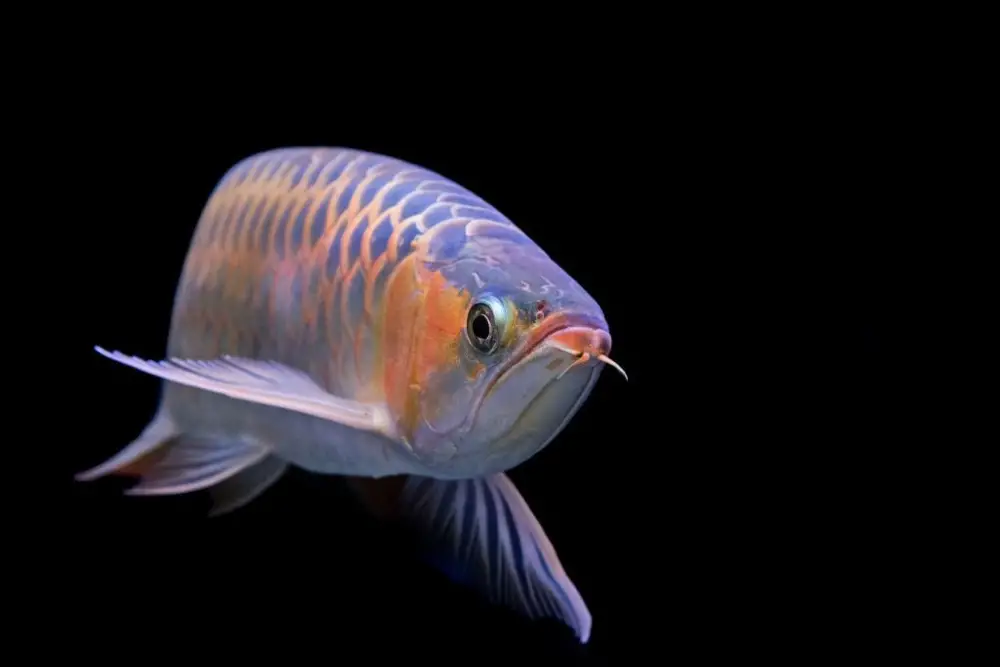
Please ensure that before adding any new fish to a tank, it’s properly cycled. That’s where a quarantine tank can be very valuable.
| Tank Size | 100 gallons (around 378 liters) per adult Arowana |
| Temperature | 75°F – 82°F (24°C – 28°C) |
| pH | 6.5 – 7.5 |
| Water Type | Freshwater |
| Hardness | Moderate to slightly hard, 6 – 12 dGH (107 – 214 ppm (parts per million) of total dissolved solids (TDS)) |
| Substrate | Sand substrate — resembling natural riverbeds for foraging, safety, and barbel sensitivity |
| Filter | Yes, Arowanas need robust canister or sump filtration with strong water flow for efficient mechanical and biological cleaning |
| Plants | Yes, Arowanas prefer hardy plants like Anubias, Java Fern, Amazon Sword, Java Moss, and Anacharis |
Tank Size
Arowanas are graceful giants that need plenty of space to show off their impressive moves. As they grow, they can reach substantial lengths, so a spacious tank is a must. For a single adult Arowana, aim for a tank with a minimum floor size of around 100 gallons (around 378 liters) or more. The tank height should be at least a few feet to accommodate their majestic jumps.
Remember, cramped living conditions can lead to stress and stunted growth. Let’s avoid that and give our Arowanas room to roam freely and explore their underwater kingdom.
Filtration
Arowanas are sensitive to water quality, so a robust filtration system is a must. Invest in a high-quality filter that can handle the tank’s water volume and effectively remove impurities like ammonia and nitrites. A combination of mechanical, biological, and chemical filtration will work wonders for your aquatic buddies.
Remember to choose a filter that provides gentle water flow. Arowanas prefer slow-moving waters in their natural habitat, and a gentle current will mimic their comfortable environment.
Regular maintenance is key. Clean the filter media and perform partial water changes to keep the water parameters in check. A clean and healthy environment will promote your Arowanas’ well-being, making them happy and thriving in their watery abode.
As you clean your Arowana’s tank, be extra careful! Have a temporary safe space with a lid ready:
Temperature
Arowanas are tropical fish, and they thrive in warmer waters similar to their native habitats. Keep the temperature steady between 75°F – 82°F (24°C – 28°C) with an aquarium heater to keep them happy and healthy. Use a reliable aquarium heater to maintain a stable and cozy environment for your Arowanas.
Now, here’s the deal — temperature fluctuations can stress out our majestic fish, and that’s a no-go. So, invest in a good quality aquarium thermometer to keep a close eye on the temperature and make adjustments if needed.
Remember, a stable and warm tank not only keeps your Arowanas comfortable but also enhances their immune system, making them less susceptible to diseases.
Lighting
Arowanas love a natural day-night cycle, just like in the wild. Providing a regular lighting schedule of 10 – 12 hours a day will keep them in their element. Invest in a timer to mimic the rising and setting of the sun, creating a familiar and comfortable environment.
When it comes to lighting fixtures, opt for full-spectrum LED lights. Not only do they bring out the vibrant colors of your Arowanas, but they also provide energy-efficient illumination for your tank.
Avoid overly bright or harsh lighting, as it can stress out our sensitive fish. Dimmable lights are a great option, allowing you to adjust the brightness to their liking.
pH and Hardness
Alright, fish-keeping pals, let’s talk about maintaining the perfect water chemistry for our finned friends — the pH and hardness levels for our Arowana tank.
Arowanas prefer slightly acidic to neutral water conditions. Aim for a pH range of 6.5 – 7.5, which will keep them happy and comfortable. Use a reliable pH test kit to monitor the water regularly and make adjustments if needed.
When it comes to water hardness, Arowanas thrive in soft to moderately hard water. Keep the general hardness (GH) between 6 – 12 dGH to mimic their native habitats. You can achieve this by using a good quality water conditioner and performing regular partial water changes.
Remember, stable water parameters are essential for our Arowanas’ well-being. Sudden fluctuations in pH and hardness can stress them out, affecting their health.
Substrate
When it comes to the Arowana tank substrate, keep it simple and practical. Since Arowanas are bottom-dwellers, a smooth and non-abrasive substrate is ideal to prevent any injuries to their delicate underbellies.
Choose a fine gravel or sand substrate that’s easy to clean and won’t trap debris. A darker-colored substrate will enhance your Arowana’s stunning colors, making them stand out like royalty in their kingdom.
Now, here’s a cool trick — consider adding some smooth river rocks and driftwood to mimic their natural habitat. These decorative elements add visual appeal and create hiding spots for your curious Arowanas to explore.
Plants
Adding live plants to your Arowana’s aquarium not only adds a touch of natural beauty but also provides several benefits. Plants help oxygenate the water, which is a big thumbs-up for our Arowanas, especially with their love for surface breathing.
Now, here’s the deal — Arowanas can be a bit clumsy with their large fins, so choose sturdy and robust plants that can withstand their playful antics. Anubias, Java Fern, and Amazon Swords are great options that can tolerate an Arowana’s curiosity.
Avoid delicate plants that they might uproot or damage unintentionally. Using tall plants can also provide additional vertical swimming space, making your Arowana feel right at home.
Diet and Eating Habits
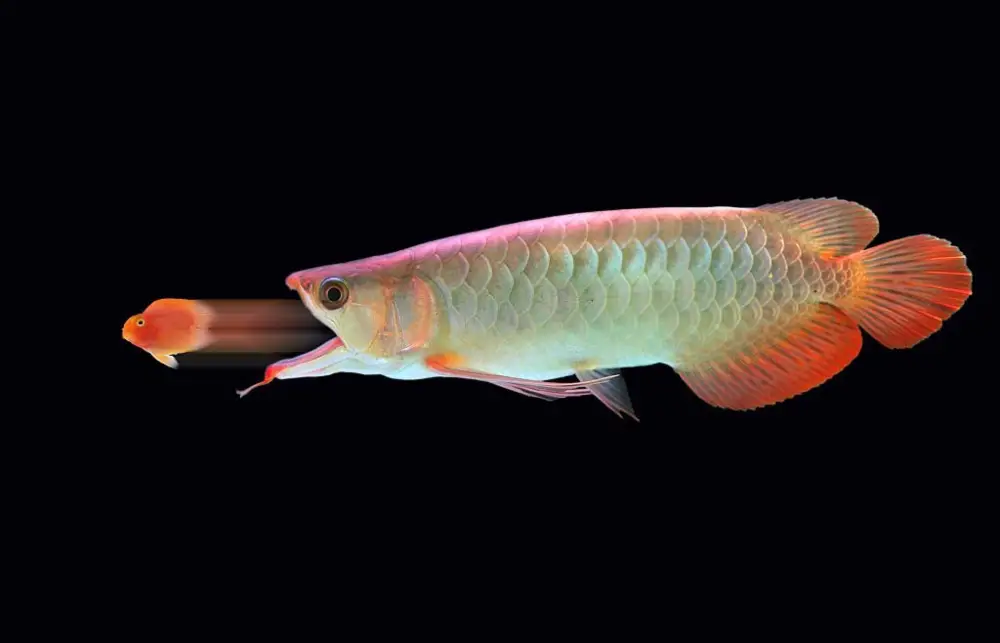
Arowanas are carnivores, and in the wild, they feast on insects, crustaceans, and small fish. In our aquariums, we can replicate their natural diet with a variety of high-quality foods. Pellets, flakes, and freeze-dried or frozen foods like bloodworms, brine shrimp, and krill are all on the Arowana menu.
Now, here’s the secret sauce — feed them a mix of protein-rich foods to keep their colors vibrant and their bodies healthy. Remember, Arowanas are notorious jumpers, so hand-feeding or using feeding tongs is a safer option.
Keep an eye on their eating habits. Arowanas tend to be “food beggars,” but overfeeding can lead to obesity and health issues. Offer a portion they can finish within a few minutes, and feed them 2-3 times daily.
Tank Mates
When it comes to tank mates, Arowanas are known to be solitary fish in the wild. However, they can coexist peacefully with the right company in a spacious aquarium.
Arowanas can be a bit territorial and may see smaller fish as potential snacks. To ensure a harmonious community, opt for fish of similar size and temperament. Large, peaceful species like Silver Dollars, Bala Sharks, and certain types of Catfish can make great tank mates.
Flaco Dos lives happily with his Discus fish tank mates over at KaveMan Aquatics:
Avoid fast-moving or nippy fish that might stress out our Arowanas. Also, steer clear of any fish that could fit in their mouth — we definitely don’t want any underwater drama.
Observing your fish buddies’ interactions is essential. Keep a watchful eye and be prepared to make changes if any conflicts arise.
Breeding
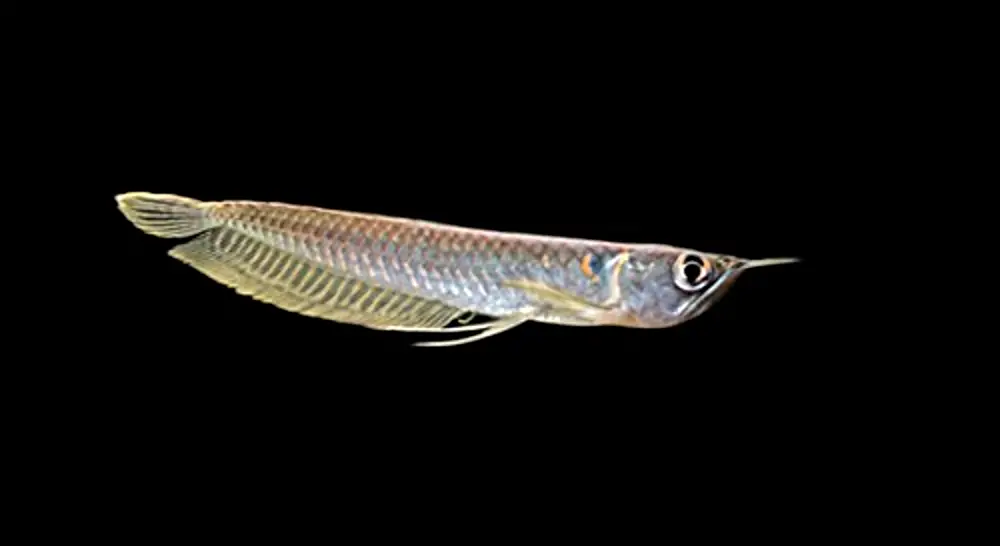
Breeding Arowanas in captivity can be a rewarding but challenging endeavor. To increase the chances of success, you’ll need to provide the right conditions. First things first — ensure you have a spacious breeding tank. Arowanas are large fish, and they need ample space for courtship and spawning.
Here is an overview of how Arowana fish breed:
- Courtship: During the breeding season, male Arowanas will display courtship behavior to attract females. This behavior includes chasing and displaying their vibrant colors to impress potential mates.
- Spawning: Once a pair forms a bond, they will engage in spawning, where the female releases her eggs and the male fertilizes them. Spawning usually takes place in open water, and the female releases a cluster of eggs while the male releases his milt to fertilize them.
- Mouthbrooding: After spawning, the female collects the fertilized eggs in her mouth. She carefully holds the eggs in her mouth, protecting them from potential threats. During this period, the female will not eat and dedicates her energy to caring for the eggs.
- Hatching: The eggs typically hatch within a few weeks, depending on the species and water conditions. Once the fry are ready to swim on their own, the female releases them from her mouth, and they begin their independent journey.
Creating a natural environment with floating plants and dim lighting can encourage spawning behaviors. And once the eggs are laid, promptly transfer them to a separate rearing tank to protect them from hungry parents.
Breeding Arowanas requires dedication and patience, but with the right setup and conditions, you might be fortunate enough to witness the miracle of new life in your aquarium.
Your Arowana Adventure Begins!
Congratulations, fish-keeping enthusiasts, you’re now Arowana aficionados! We’ve explored the depths of Arowana care and uncovered valuable insights to ensure your majestic fish thrive in their aquatic paradise.
If you’re eager to take your Arowana expertise to the next level, look no further than KaveMan Aquatics. Our 1-on-1 coaching services are tailor-made for beginners like you. Whether it’s fine-tuning tank setup, perfecting feeding routines, or mastering breeding techniques, we’ve got you covered.
So, why wait? Dive into the world of Arowana mastery with KaveMan Aquatics by your side.
All About Arowanas — A Complete Species Profile and Care Guide
Dive into the world of Arowanas! Our complete care guide and species profile have everything beginner fish-keepers need to raise healthy Arowana fish.


